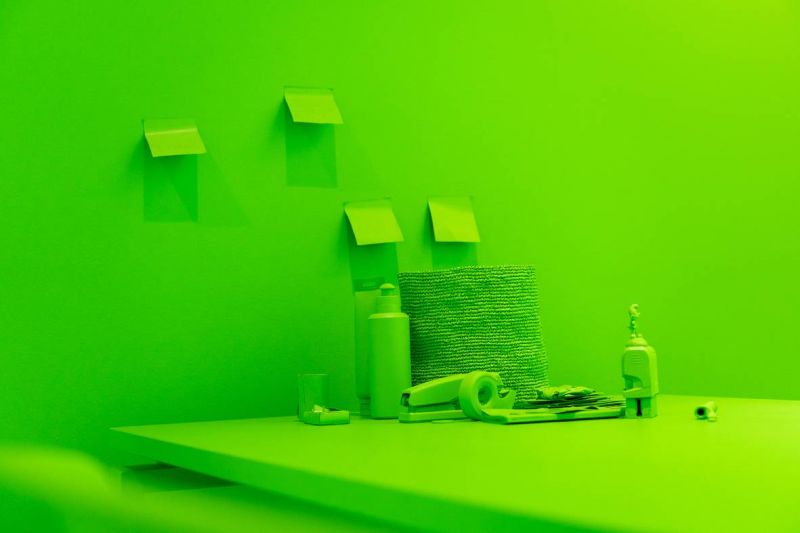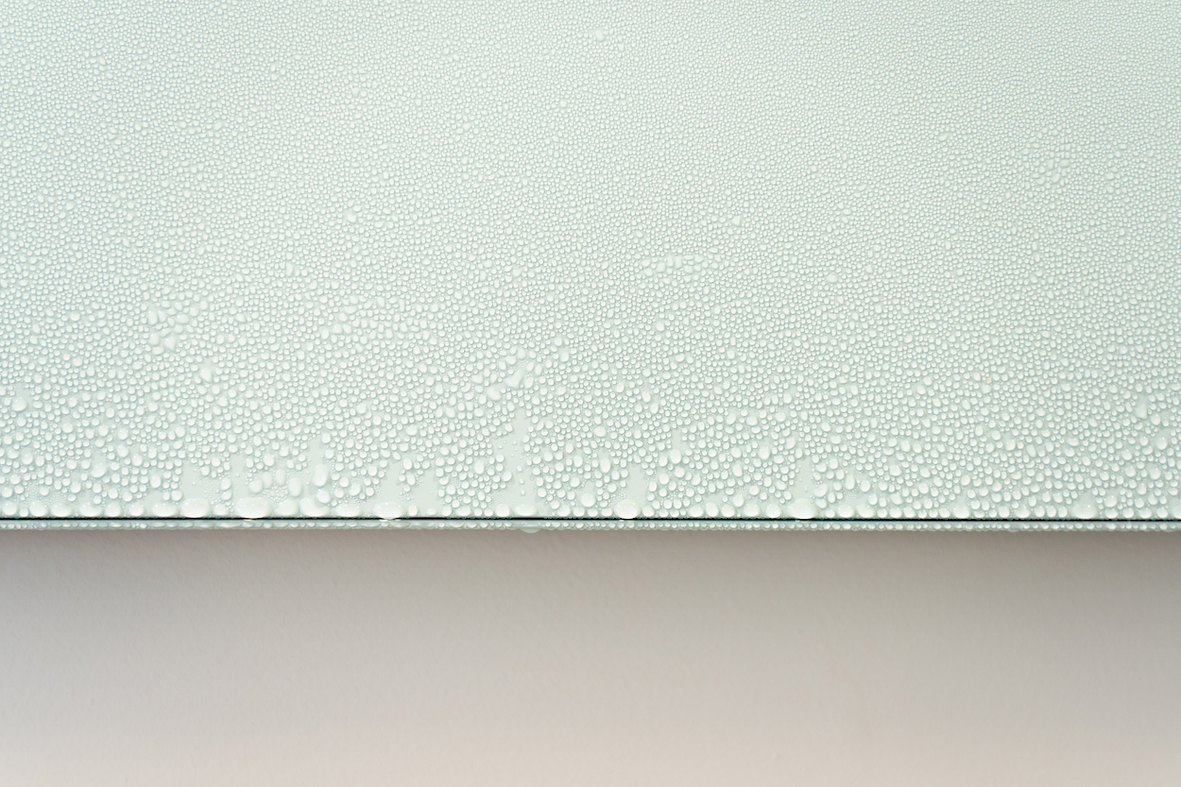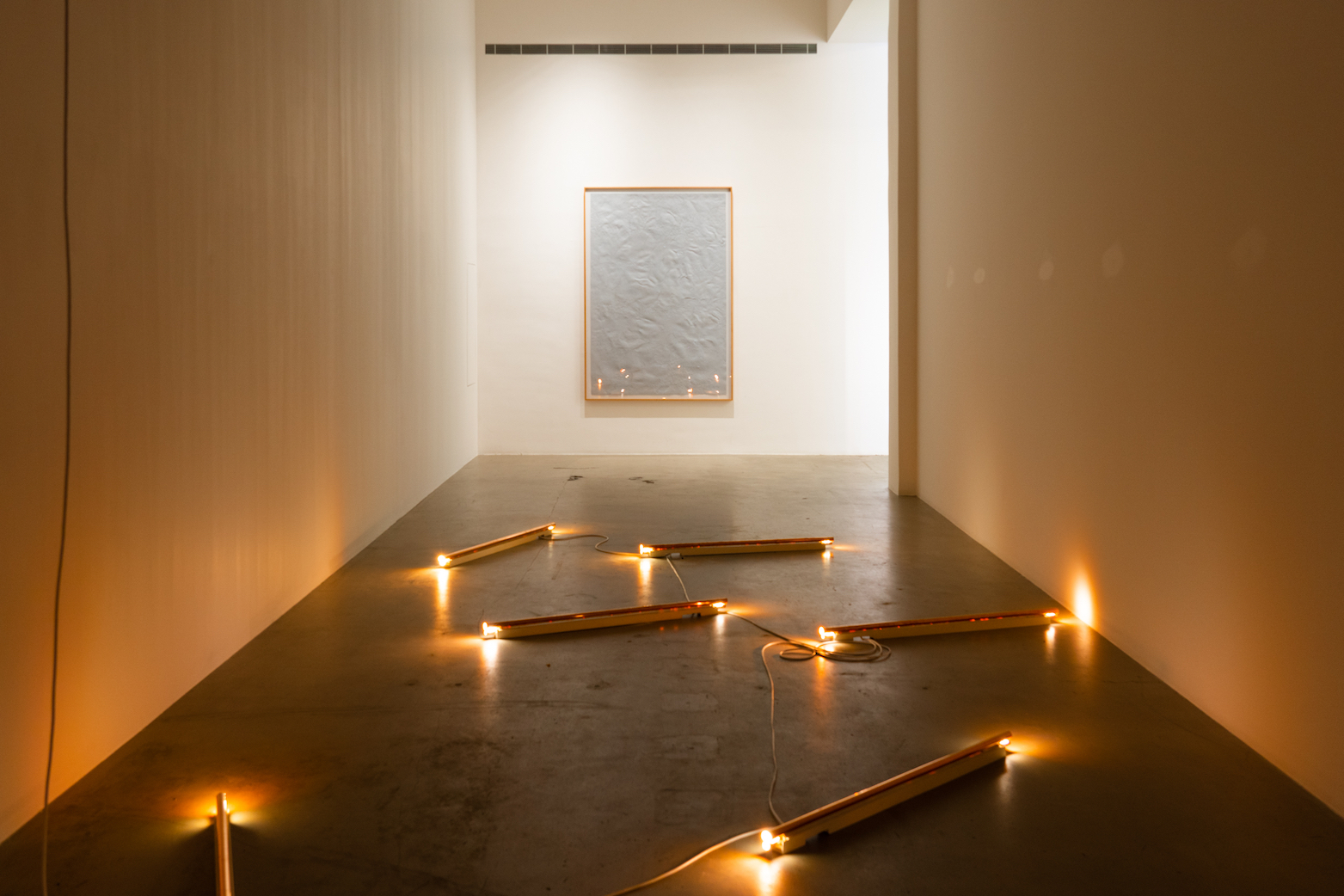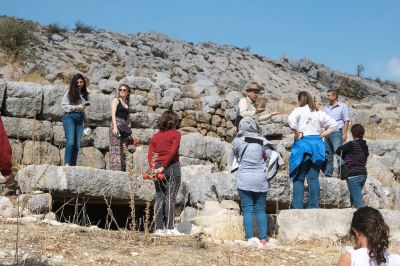
‘Vanishing Act,’ 2023. Mixed media (green screen paint, walls, floor tiles, desk and miscellaneous office supplies), dimensions variable. (Courtesy of: Marfa’ Projects)
BEIRUT — For Caline Aoun, materiality is all.
“If you look at an image on a billboard, say, and the same image on your [computer] screen, or on an iPhone, or in a magazine — they’re not the same image,” the artist says. “They are completely different, because materially they’re worlds apart.”
Aoun is in the office of Marfa’ Projects, currently resplendent in an unnatural shade of saturated green, speaking quietly into L’Orient Today’s mobile phone-cum-voice recorder. A meter or two distant, her show “Are Androids Covered with Electric Dew?” is being mounted in Marfa’s twin galleries. The thuds and crashes of installation resonate competitively with the artist’s recorded voice.
Marfa’ is a compact space and “Electric Dew” is a small exhibition of four works from 2023. “Nature’s Time Capsule,” a series of three pine needle-on-handmade paper works, is complemented by two pieces that might be termed “machine art,” inasmuch as they’re premised on technological modification of the interior environment. The fourth work, “Vanishing Act,” is a technologically informed, but fully analog, installation.
Aoun’s body of work tends to explore an intriguing space where nature and technology cross paths.
Most recently her art adorned Hosn Niha in the Bekaa Valley, where last October the archaeological ruin served as the venue for her “Presences from the Sun,” a Sol-activated work comprised of mirrors, texts reverse-stamped into metal sheets and the ancient stone blocks upon which these historic epigrams were projected as the sun followed its circuit overhead.
“The Kinetics of the Invisible,” a piece Aoun exhibited during “Water,” a group show staged at Marfa’ in 2021, looks quite unlike “Presences,” yet it occupies the same terrain. While the other works in that show were variously concerned with figuration — depicting the appearance of water — “Kinetics” made it.
A ceiling-mounted refrigerator compressor froze the moisture condensing on a copper pipe protruding from it. A timer switched off the refrigeration unit from time to time, allowing the ice to melt and drip into a tub set on the floor beneath. Over the course of the show, humidity in the gallery air underwent a cycle of condensation and evaporation, freezing and melting.
This performative mimesis does not imitate the appearance of water. It mimics the biosphere (aka “Earth”) — whose natural regulatory cycles are being thrown so desperately out of whack by a species that makes, and may appreciate, art.
Like “Kinetics,” half the works in “Are Androids Covered with Electric Dew?” engage with the ambient air, water, heat and light that surround and permeate the gallery’s visitors as they eyeball what Aoun has made.
“I’m really hoping that viewers can be reminded that the spaces we live in, all kinds of spaces, are not inert or static” and, as Aoun’s written introduction to the exhibition puts it, “how artificial mechanisms can change the way we engage with our physical surroundings.”
“Artificial Dew, The Machine’s Morning Creation” comprises a series of portrait-shaped monochrome works, whose colors range from pale blue to brown-tinged red.
 A detail from ‘Artificial Dew, The Machine’s Morning Creation,’ 2023. Compressor, aluminum sheet, paint, 110 x 160mm. (Courtesy of: Marfa’ Projects)
A detail from ‘Artificial Dew, The Machine’s Morning Creation,’ 2023. Compressor, aluminum sheet, paint, 110 x 160mm. (Courtesy of: Marfa’ Projects)
“It’s the sky. I took lots of I-phone photos of the sky while, you know, driving,” Aoun smiles, gesturing to a pale-blue piece.
“A polluted sky at dawn,” she nods to a brown-tinged monochrome. “That’s how I’d describe this one.”
Monochromatic paintings emerged among the 19th century avant-garde and persist to this day, but the appearance of these pieces is deceptive. They may evoke art history but they use the same technology as “Kinetics.”
“It was important for me to reiterate [‘Kinetics’] but on surfaces,” she says, “surfaces of the kind and scale so common in a gallery space.”
Anyone daring to touch the edge of one of these aluminum-sheets might find them quite cool. They also appear to be sweating.
“Sweating, crying,” Aoun laughs. “People see so many different things in this condensation. This one’s off at the moment. It had started to ice over.
“I noticed these works change so much every day. It’s interesting that the sheet not only registers the humidity coming out of our breaths, but also the traffic of people.”
Marfa’s second gallery is showing “Radiant Alchemy,” the fraternal twin of “Artificial Dew” — “diagrams of temperature,” as Aoun puts it, with one generating water, while the other is concerned with light and heat energy.
 ‘Radiant Alchemy,’ 2023. Florescent lights, rolled copper plating; background, ‘Nature’s Time Capsule,’ 2023. Handmade paper, pine needle impressions, 144 x 210mm. (Courtesy of: Marfa’ Projects)
‘Radiant Alchemy,’ 2023. Florescent lights, rolled copper plating; background, ‘Nature’s Time Capsule,’ 2023. Handmade paper, pine needle impressions, 144 x 210mm. (Courtesy of: Marfa’ Projects)
The work consists of eight cylindrical fluorescent lights, removed from the ceiling and arrayed on the gallery floor. Each bulb has been covered in a sheet of rolled copper — long prized for its heat-conducting properties. While a ghostly light does escape the poles of the eight strips, they’ve otherwise been transformed into heaters.
“Light and heat are two different forms of energy but light can be converted into heat through absorption by material,” Aoun reflects. “In Lebanon these days we feel the need for heat and water more than ever, with people struggling to find enough of both.”
A winking example of artificially changed space will be found in the office of Marfa’ Projects, currently retooled for Aoun’s piece “Vanishing Act.”
The space’s surfaces — walls, floor, chair, desk and the objects on the desk (a stapler, a water bottle, etc.) — have been painted the same saturated green hue used in green screen technology, a staple of television and movie special effects. Whenever viewers see actors gamboling across some inaccessible or deadly landscape, chances are one camera has shot the location while another has captured the actor pantomiming his role before a green screen, the featurelessness of which makes it simpler to superimpose the footage of the human over that of the location.
Aoun says the work was inspired by the purported neutrality of featureless white cube-style galleries.
“We tend to have them neutral and white, to have them disappear as much as possible,” she says, “but this can never happen, because this space is very physical and it has so much infrastructure behind these walls. It’s only through digital technology that you can make it ‘really’ disappear. So the work plays on that [fiction].”
Aoun says “Vanishing Act” is also inspired by “entropy, entropic spaces, and how objects accumulate.” (In thermodynamics, very basically, entropy is the condition in which a system lacks thermal energy to be converted into mechanical work, which increases the degree of disorder or randomness in the system.)
“I was looking through Marfa’s office space, at what they had lying around,” she says, gesturing to the now-bright green desk L’Orient Today is leaning on. “Most of the stuff they don’t even use anymore. It’s just piling up.”
Aoun says her work has long been interested in the long-term accumulation of matter.
“It’s like a material manifestation of time passing,” she says, “so it’s also a way of measuring the passage of time. [‘Vanishing Act’] plays on how to make accumulated matter disappear.”
The work stops short of actually digitizing the space on a screen.
“I love the feel of the analog,” she says. “We’re gonna clear the space, but I’m hoping that we can keep it functional as an office, in as much as they can handle all the green.”
She laughs quietly and nods to the gallerist’s laptop and other ephemera scattered among the now-green objects there, like overlapping temporalities.
“Having these colored objects in that space — how the other objects have accumulated on top of the previous green ones — it’s almost like time zero, like a time measure.”
Caline Aoun’s “Are Androids Covered with Electric Dew?” opens at Marfa’ Projects March 8, 6-8 p.m.

